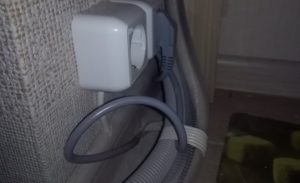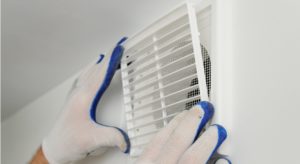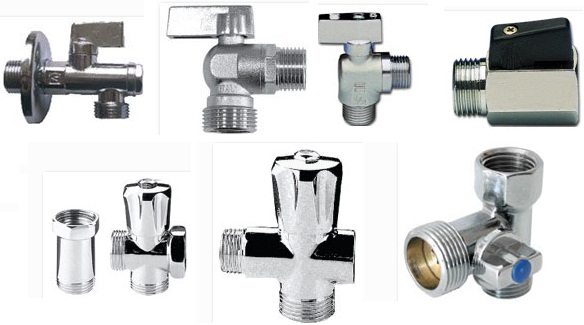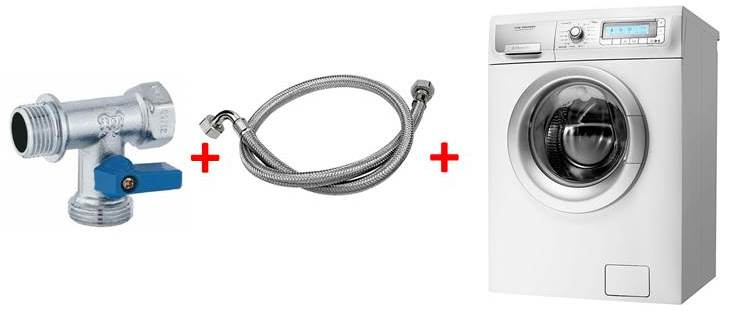How to put a washing machine in the dressing room
 Often the most optimal solution is to install a washing machine in the dressing room. This option saves space in the bathroom and in the kitchen, but creates some difficulties with summing up communications and other preparation of the place for the machine. It is necessary to evaluate the hardness of the floor, calculate the distance to the water supply and sewerage system, re-equip the outlet and think about ventilation. How feasible it is and whether the game is worth the candle - find out a detailed analysis.
Often the most optimal solution is to install a washing machine in the dressing room. This option saves space in the bathroom and in the kitchen, but creates some difficulties with summing up communications and other preparation of the place for the machine. It is necessary to evaluate the hardness of the floor, calculate the distance to the water supply and sewerage system, re-equip the outlet and think about ventilation. How feasible it is and whether the game is worth the candle - find out a detailed analysis.
Evaluation of installation options
Immediately ditch the walls for a new outlet and drag the machine into the dressing room is definitely not worth it. First you need to evaluate the place to install the machine. First of all, we find out whether the washing machine will fit into the space allotted for it: carefully measure the width, depth and height, not forgetting the protruding elements. We add another 7-10 centimeters to the resulting values - hoses should fit behind the unit, and the sides should not be squeezed by neighboring objects.
If there is no problem with accommodating the dimensions, we proceed to the assessment of the flooring. A solid floor is required that does not bend under a weight of 70-80 kg. Ideally, concrete or tile. Wood, particleboard, linoleum is prohibited, otherwise there is a high probability of the body falling through and the occurrence of an imbalance of the drum during washing. The unevenness of the floor does not matter: the main thing is to use the building level to adjust the legs of the washing machine.
The distance to the nearest communications is also important. So, when removing the sewer pipe from the intended place of 3 meters or more, it is better to refuse the idea of placing the machine in the dressing room. Pumping dirty water will become too heavy a load for the pump and cause it to break prematurely. You can solve the problem by installing an additional pump, but it will be more expensive and more difficult technically.
It should be borne in mind that for most washing machines, hoses on average have a length of 1.4-1.5 m, and for pulling to more distant distances, you will have to change it to a more authentic sample or build up with special nozzles.
We also think over options with the organization of adequate ventilation. Washing is eternal humidity, so ventilation is necessary to prevent dampness, mold and mildew. Constantly keeping the door to the pantry open is uncomfortable and ugly, only a forced air system is suitable.
This is not to say that installing a washing machine in a dressing room is an impossible mission. But if the upcoming work is too troublesome and financially expensive, then it is better to place the machine in the kitchen or bathroom. If difficulties are easily circumvented or solved, we get down to business.
Connection to water and sewage
The most difficult thing is to connect the unit to the water supply and sewerage. Moreover, the early methods of joining the central water supply using taps and a piece of rubber sleeve are not relevant now. Now the inlet and outlet hoses are already built into the washer and you need to screw them to the pipes using bends or tees.
It is better to install adapters with a shut-off valve, which will allow shutting off the water after the end of the cycle, during repair work or moving the machine to another place.
The task is simple - cut a hole and install a tee in it. The sequence of actions and the necessary tools depend on the material of the pipe. So, it is easier to run into PVC with cold water supply: mount the adapter with a tap and connect the washing hose to the outlet. Also connected to the machine and sewer. But in the absence of proper experience, self-tapping is not recommended: it is much more reliable to turn to a professional plumber for help.
Install the outlet
Outlets in the dressing room are rare, but even if it is available, it is better to install a new one. The fact is that a washing machine requires more power, therefore, wires must be supplied with a sufficient cross section. Otherwise, the conductor will overheat, ignite and provoke a fire.
Using an extension cord to connect the machine is not recommended - it is better to arrange direct contact with the mains.
To convert a power outlet or install a new one, you will need: 
- socket with waterproof housing;
- new wiring with a cross-section of a core of at least 2 square meters. mm .;
- socket;
- drill or chisel cutter.
When all the tools and materials are prepared, proceed to installation. First, select a place for a new outlet, and then turn off the current supply to the apartment. After we act like that.
- Do the markup. We measure the height for the future outlet within 30-100 cm from the floor and with a pencil we outline the corresponding hole.
- We consider how much meter wiring you need to lay from the washing machine to the junction box. It is recommended not to forget about a margin of 20-30 cm to facilitate installation and possible repairs. The path to the shield is marked with a pencil.
- We supply a drill with a nozzle suitable for the type of wall and electrical fittings.
If there is no suitable drill nozzle, then you can use the standard one: it is enough to drill several holes in the wall, and then remove the remains with a chisel and hammer.
- We put on personal protective equipment: glasses, a respirator and gloves.
- We connect the door to the mains. The use of an extension cord is permitted, as it is not necessary to limit the fluency of the tool.
- Carefully drill a hole for the outlet, focusing on the marked markings.
- We make a 2-3-cm strob using a grinder or a chisel with a hammer.
- We clean all the drilled holes from dust and the remnants of building materials.
- We get the socket and fix it in the hole made.
- We lay the wire in the groove and put one end into the shield, and the other into the socket.
- We cover the holes with wires with gypsum or putty and wait for complete drying.
- We insert the socket and connect the wires.
- We head to the shield and connect the conductors to the corresponding contacts. It is strongly recommended that you use terminals for connections, since it is dangerous and unreliable to twist the wires.
Once again, we check the reliability of the fasteners and turn on the general electricity. For several minutes, we try to catch a suspicious smell or the presence of smoke. Lastly, insert any household appliance into a new outlet and evaluate the quality of the current supply. If everything is done correctly, then there will be no problems.
Ventilation organization
It would seem that with electricity and water supply, the washing machine can be put in the dressing room and begin its operation. But do not rush if your pantry occupies a minimum of square meters and does not have windows with windows. A closed room devoid of ventilation slots is categorically not suitable for a moisture-distributing machine. You will have to organize ventilation in the following ways:
- Make a gap between the door and the floor.
- Choose a special door with ventilation grilles or openings equipped in the canvas.
- Drill several holes in the walls at a distance from the floor to 30 cm. Ideally, 5 cm above the skirting boards.
- Leave at the top of the partition special gaps of 2-3 cm.
- Think over the ventilation hole in the floor when considering private houses with a lower floor / basement with permissible humidity.
A normal dressing room should have a free flow of air, as in the absence of oxygen circulation, things begin to smell unpleasant and become dirty faster. Moreover, there are norms for the size of the supply openings, which depend on the occupied square meters and the source of ventilation.So, to ensure a one-time exchange in a room with a width of 1.5 m, a length of 2 m and a height of 2.8 m, 8.4 cubic meters of air is collected, and in an hour it should be completely updated due to incoming and outgoing flows. But this is with standard storage of clothes, and with the installation of a washing machine, the figure should be increased three times.
Calculating the amount of air in the dressing room is simple: just multiply its length, height and width.
In a room with normally working ventilation, it is enough to make a hole for air flow with an area of 100 cm. The shape is not important - it is permissible round, square and rectangular. It is not prohibited to increase the size.
In addition to the supply gap, it is necessary to organize an exhaust duct. It will be a similar ventilation grill, but located on the opposite side of the room and preferably closer to the ceiling. Ideally, it should be as far away as possible so that the circulating air envelops the entire room. If the air intake is planned from the middle of the room, then there should be two “exits” - to the right and left, indented from corners up to 25 cm. It is best when the air from the dressing room enters the ventilation duct and enters from the street.
Only by strengthening the floor, having thought about connecting to communications, organizing air circulation and making a powerful outlet, you can move the washing machine into the pantry and use the machine for its intended purpose without risks. If everything is done correctly and wisely, interruptions in the supply of water, a short circuit and mold will not threaten washing and the home.
Interesting:
 Adapters for a washing machine for sewage and water
Adapters for a washing machine for sewage and water How to install a washing machine in the bathroom yourself
How to install a washing machine in the bathroom yourself How to install a do-it-yourself washing machine in the kitchen
How to install a do-it-yourself washing machine in the kitchen How to connect a dishwasher to the water supply and sewerage
How to connect a dishwasher to the water supply and sewerage How to connect a washing machine and dishwasher
How to connect a washing machine and dishwasher We select and install a tee crane for a washing machine
We select and install a tee crane for a washing machine
Reader Comments
- Share your opinion - leave a comment
Headings
Washing machine repair


For buyers
For users

Dishwasher












Add a comment